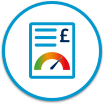Understand Your Energy Bill
Energy Bills vary from supplier to supplier and are not the easiest to understand but, they all show the same sort of information.
Whoever your supplier is, your bill should contain the following:
Tariff name
Usually found on the first or second page of your bill. There are hundreds of tariffs on the market, so it’s really important to know the exact name of your current tariff to get the most accurate comparison.
Previous 12 months cost
This is a quick and easy figure to see how much you paid in the past 12 months.
Next 12 months estimate
This is what your energy supplier thinks you will pay in the coming 12 months, if you stay on the same tariff and use the same amount of energy.

MPAN/MPRN numbers
These reference numbers uniquely identify your electricity (MPAN) and gas (MPRN) meters and might be needed if your exact meter can’t be determined when switching.
Read How do I get a fairer deal with my current Energy provider?
Current balance
This shows where your account is up to financially. If you pay quarterly you’ll be asked to clear this amount or if you pay by direct debit, this figure is just for information to let you know whether you’re in credit or debit. Suppliers will let your account go a certain amount in debit before increasing your monthly direct debit amount. You can always question this amount or any large credits/debits with your supplier. It’s also worth noting that everyone generally underpays in the winter (when usage is high) and overpays in the summer (when usage is far lower). The correct direct debit amount is one that evens itself out over 12 months.
Meter readings
Your bill should show you the most recent reading and the one before that, also whether they’re estimated (shown by an ‘E’ next to the reading) or actual (‘A’ if your meter was read by someone coming to your house, or ‘C’ for customer if you submitted it yourself).
Discounts/premiums
These must be shown in contrast to standard tariffs, where payment is by direct debit. Unit rates, standing charges and Tariff Comparison Rates. (TCR)
Your bill will show you how many kilowatt hours you’ve used since your last bill and what you paid per kWh. However, you should also look at your standing charge, a daily fee that every supplier charges on top of your usage.
You will also find a Tariff Comparison Rate on your bill – this is important and helpful. The TCR allows you to compare a single figure against other suppliers. It is a single figure that takes into account unit rates, standing charges and any discounts that may apply to your current plan.
Read How can I reduce my energy bill?
Contract details
There should be a summary of the terms of your contract, e.g. the date your current tariff ends, early exit fees etc. This is very important to check if you’re considering switching, to make sure that you won’t pay high exit fees if you leave before the tariff ends. If your current deal has ended, it’s likely that you’ll now be on a standard rate.

Is your bill fair? Check my bills

